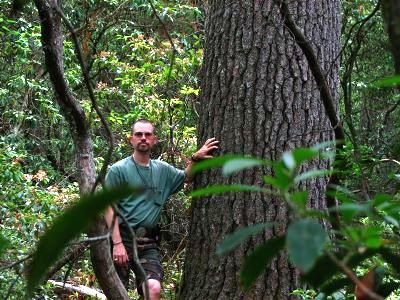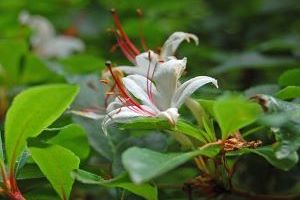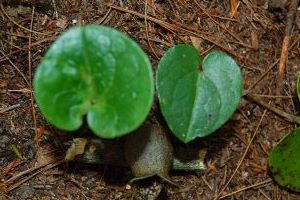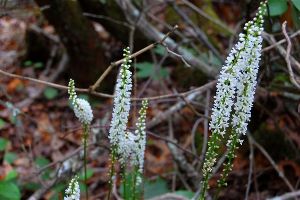|
==============================================================================
TOPIC: Pink Beds Loop Trail_PNF NC
http://groups.google.com/group/entstrees/browse_thread/thread/013acb5429883638?hl=en
==============================================================================
== 1 of 1 ==
Date: Fri, Jun 20 2008 9:57 pm
From: James Parton
ENTS,
Last July my sister Becky, I and her two kids Levi and Matthew hiked
the 4.5 mile Pink Beds Loop in the Pisgah Ranger District of Pisgah
National Forest NC. I noticed then that they were some really nice
sized trees there with the White Pines leading in height. Today, I
stayed out of work and hiked back around the loop with Becky and
kids as well as Joy and Mom. The trail is a really nice one with
abundant wildflowers and in some places a solid carpet of bright
green ferns covering the forest floor. The place is just magical.
This year I not only returned with my camera but also rangefinder
and clinometer. I had forgotten my calculator at home so I had to do
the math part of the measuring upon returning home.

10 ft. 4 in,. cbh White Pine |

Becky and 6 ft. 9 in. Pitch Pine |

Pink Beds White Pine |

Chinkapin |
There are so many large White Pines there that it would take a solid
day of measuring to get a really good idea of their size. A second
person would be of great help. I feel the majority of my
measurements today came up a bit low. This time of year with all of
the leaves out it is often hard to see the true tops of trees to get
an accurate measurement of them. Winter would be best. But I did the
best I could do today. I feel they are some 150+ White Pines in here
and some Pitch Pines better than 110 feet. If any ENT wants to
return with me here you have my invitation ( Will Blozan,
hint!..hint!! ). There are also some decent hemlock here but they
are failing to hwa.
Joy found a fairly recent cut oak in which I counted an average of
144 rings after counting them 3 times. This tree was a bit over 2
feet in diameter. We did not measure it. This gives me a hint of
what may be the older trees in the forest. Also some of the largest
White Pines are close to 4 feet in diameter. This area has
experienced logging in the past and I was surprised to find a
ring-count of much over 100 years. The large whites also hint at the
possible 100+ age of the forest, at least in places but size alone
cannot be used to date the trees.
Both American Chestnut and Allegeny Chinkapin ( Chinquapin ) are
found scattered in the understory. Both showed blight killed
sprouts. I also found a few that may be natural hybrids between them
( Chinknuts ). I found several blight killed American Chestnut
trunks about 20 feet tall and one close to 30. However I found one
living tree that was about 25 feet tall. I saw several Chinkapins
blooming as well as one American Chestnut!
I plan to do a post on the other flora of this forest but that will
have to wait until the near future.
Here are the measurements. All are Eastern White Pine except a Pitch
Pine and Red Spruce.
White Pine.
CBH Height
8' 8 1/2" 111. 39'
10' 4" 127. 35'
9' 3 1/2" 119.08'
10' 5" 139.30'
8' 9 1/2" 140.72'
123.0'
117.01'
8' 10"
116.08'
Pitch Pine.
6' 9 3/4" 102.29'
Red Spruce.
97.51'
The Red Spruce was growing at an altitude much lower than it is
usually found. I could only guess how it got there. Maybe someone
planted it in years past?
James P.
==============================================================================
TOPIC: Pink Beds Loop Trail_PNF NC
http://groups.google.com/group/entstrees/browse_thread/thread/013acb5429883638?hl=en
==============================================================================
== 1 of 1 ==
Date: Mon, Jun 23 2008 10:28 am
From: James Parton
ENTS,
I wanted to add a couple of websites concerning the hike.
http://www.localhikes.com/Hikes/PinkBedsLoop_0000.asp
http://www.hikewnc.info/trailheads/pisgah/pisgah/guidedhikes/pinkbeds.html
James P.
== 1 of 7 ==
Date: Tues, Jun 24 2008 8:36 am
From: James Parton
ENTS,
Friday, my family and I hiked the Pink Beds Loop Trail and observed
some beautiful wildflowers there. Maybe some of you can help me
identify some of them.
The Pink Beds is an area located in Pisgah National Forest between
North Mills River Campground and hwy 276 on the headwaters of
Davidson River. Yellow Gap Rd ( unpaved ) follows the valley between
the campground on Mills River and hwy 276. Growing up, I hiked here,
camped here, and hunted and fished here. The area has changed a bit
over the years though, the most notable thing being the dying
hemlocks. The Pink Beds is named for the abundant Rhododendron and
Mountain Laurel which blooms abundantly here in the spring and early
summer.

American Chestnut |

DSC 6194 Swamp Azalea. ( Rhododendron Viscosum ) |

DSC 6198 (Clintonia umbellata) |

DSC 6211 Wild Ginger (Hexastylis
shuttleworthii ?) |

DSC 6215 Wild Ginger (Hexastylis
shuttleworthii ?) |

DSC 2228 Cinnamon Fern (Osmunda cinnamomea) |

Galax |
|
The access area of the trail is at the Pink Beds picnic area
which is located just below where Yellow Gap Rd comes into 276, just
above the Forestry Discovery Center. Most people think of this
picnic area as the Pink Beds. The trail starts at a gate at the far
end of the lower parking lot.
Earlier I did a general post on the forest of the Pink Beds loop but
reading on the Baxter Creek wildflowers made me think of doing one
on the abundant Pink Beds wildflowers.
Some I could identify. Galax and Rhodo/Laurel, for example. But many
I did not know. See if you can id the ones with just the photo
number by the images. One really parculiar one that my sister Becky
found had a heart shaped leaf which reminded me of Galax but had a
odd greenish/purple bell shaped flower. It was strangely beautiful.
The place had some beautiful ferns. In some areas the forest floor
was covered in them! One species was quite large. Some breast high
with tall spore-bearing stalks. We almost expected Raptors to come
charging out of them! The area also has abundant mountain bogs and
creeks. The White Pines here are awesome!
One azalea had a wonderful cinnamon-like fragrance. It's flowers
were white with reddish stamens. It perfumes the air anywhere near
it and we could smell them sometimes before even seeing them.
Ok, try to id the DSC_number images....
James Parton
== 2 of 7 ==
Date: Tues, Jun 24 2008 9:18 am
From: Elisa Campbell
James,
Maybe Cinnamon Fern (according to a web page I found of people
discussing what ferns they can grow, apparently in South Carolina,
Cinnamon Fern will grow there. Here's a link to a great page about
ferns from the Connecticut Botanical Society:
http://www.ct-botanical-society.org/ferns/osmundacinn.html
Cinnamon Fern
Osmunda cinnamomea
This is Connecticut's largest fern. Its fiddleheads are food for
ruffed
grouse, and hummingbirds sometimes use the fuzz on young fronds to
line
their nests.
. Family: Osmundaceae
. Habitat: swamps, streambanks, shores
. Height: 2-5 feet
. Location of spores: separate fertile fronds are cinnamon-colored,
narrow and erect
. Stipe (leaf stalk): round and slightly grooved; at first covered
with
cinnamon-colored hairs, later smooth and green
. Growth pattern: symmetric clump
. Persistence: deciduous
Elisa
== 3 of 7 ==
Date: Tues, Jun 24 2008 9:44 am
From: James Parton
Elisa,
This sure looks like it! It is the largest fern I have seen around
here.
Thanks: James.
== 4 of 7 ==
Date: Tues, Jun 24 2008 9:54 am
From: Josh
James,
I'll give these a crack and see if Jess - the emerging botanical
expert of our group - can improve on my guesses:
From the top:
Rhododendron viscosum - my best guess without being able to look at
the leaves and glands with a hand lens
Clintonia umbellata - very dark green and long leaved for Clintonia.
I'd like to see this up close
Hexastylis sp. - Definitely Hexastylis. Ditto for this one. I need a
specimen and hand lens to i.d. these. Judging from the size of the
flower and time of year, I'll have to go with Hexastylis
shuttleworthii, the largest flowered of the "heartleafs"
or "little
brown jugs".
Cinnamon fern for sure.
I like the plant i.d. game. Keep em' coming.
Josh
== 5 of 7 ==
Date: Tues, Jun 24 2008 7:19 pm
From: ForestRuss@aol.com
James:
I am pretty sure that the small brown flower with the unusual shape
is a
variety of wild ginger.
Russ
== 6 of 7 ==
Date: Tues, Jun 24 2008 7:58 pm
From: "Steve Galehouse"
Russ-
I think Hexastylis and Asarum are one-and-the-same. Wild ginger as a
common
name.
Steve
== 7 of 7 ==
Date: Tues, Jun 24 2008 8:46 pm
From: James Parton
Steve, Russ & Josh,
Thanks for the lesson in id'ing plants. I am still awaiting Jess
Riddle's input.
Yes, according to sources on the web, Hexastylis, Asarium and Wild
Ginger are the same. The unusual plant is definitly a variety of
Wild
Ginger.
Swamp Azalea. ( Rhododendron Viscosum ) Very possible. The flowers
vary somewhat from white to pink according to Internet sources. The
fragrance is very pleasant.
I never could find a good picture of Clintonia but the one I found
looked really close.
James P.
TOPIC: Pink Beds Wildflowers_PNF NC
http://groups.google.com/group/entstrees/browse_thread/thread/b729a160b37c65db?hl=en
==============================================================================
== 1 of 5 ==
Date: Wed, Jun 25 2008 8:34 am
From: "Jess Riddle"
James and all,
I agree with Josh's id's. The deciduous Rhododendron's are a group
that I haven't gotten around to working with, so I can't tell if the
one in the photo is viscosum or not. Clintonia is the first thing
that jumped to mind for the next photo, but the leaves are
surprisingly shiny and upright. Also, C. umbellata was already
flowering a month ago, so I'm not sure about this one. The next two
photos are definitely Hexastylis, and Josh's guess for the species
is
better than mine. Hexastylis and Asarum are two closely related
genera, lumped together by some authors, but the names can not be
used
interchangeably. Asarum has larger, lighter green, fuzzy, paired
leaves while Hexastylis has dark, evergreen hairless leaves. Asarum
typically grows in rocky, moist, rich sites while Hexastylis is
generally on acidic sites. The name "wild ginger" is
generally
applied to Asarum. The ferns are definitely cinnamon fern.
For any wanting to learn their southeastern plants, I highly
recommend
Weakley's Flora. You can download it for free at
http://herbarium.unc.edu/flora.htm.
The guide does not include
pictures or measurements of plant parts, but the keys are we thought
out and the most user friendly I have encountered. The habitat
descriptions are also better than I've seen in most field guides.
Jess
== 2 of 5 ==
Date: Wed, Jun 25 2008 12:29 pm
From: "Will Blozan"
Jess, Josh,
I think (and could be wrong) that the Hexastylis are
"evergreen" whereas the
Asarum are "deciduous". It shows in the leaf texture with
Asarum being quite
thin whereas Hexastylis is thick and leathery.
Will
== 3 of 5 ==
Date: Wed, Jun 25 2008 5:45 pm
From: "Steve Galehouse"
Europen ginger, Asarum europaeum, a frequently grown ornamental
perennial,
is evergreen.
== 4 of 5 ==
Date: Wed, Jun 25 2008 8:01 pm
From: James Parton
Will,
These had an evergreen look. Like Galax.
JP
== 5 of 5 ==
Date: Wed, Jun 25 2008 8:41 pm
From: James Parton
ENTS,
Pink Beds Area
Adjacent to the Cradle of Forestry, the Pink Beds are a network of
upland bogs supporting habitats more like those found on the Coastal
Plain than the mountains. In the shadow of looming formations such
as
Looking Glass Rock and Mount Pisgah, the Pink Beds are remarkably
level, making them a popular destination for hiking and mountain
biking. A network of trails lacing through the area include the Pink
Beds Loop Trail, South Mills River Trail, and a segment of the
Mountains-to-Sea Trail.
Trails pass through lush stands of rhododendron and mountain laurel.
One legend has it that their pink and white blooms give the area its
name. Another legend, however, claims this was meadowland filled
with
all kinds of flowers and that Scots-Irish settlers typically used
the
word "pink" to describe flowers in general. Above this
understory
flourishes a mixed canopy of red maple, yellow-poplar, northern red
oak, southern red oak (Quercus falcata), Eastern hemlock (Tsuga
canadensis), and white pine. At South Fork Mills River's junction
with
its tributary, Bearwallow Brook, a grove of huge white pines
dominates
in a beautiful and peaceful setting.
Thick, shiny-leafed stands of dog-hobble (Leucothoe axillaris) droop
over the streams as if protecting them from intruders. Nearby
numerous
mats of ground pine (Lycopodium obtusum) cover areas free of
understory, and occasional rosettes of rattlesnake plantain (Goodyera
pubescens) can be found as well. There are also a number of
shortleaf
pines (Pinus echinata) scattered throughout the area closest to the
US
276 parking-area trailhead. These trees grow extremely straight and,
because they drop their lower limbs under the shaded canopy, are
easily harvested for telephone poles.
The Pink Beds Loop Trail was once a 5-mile walk. However, a newly
constructed beaver (Castor canadensis) dam has flooded the
northeastern end and reduced the hike to 3.2 miles. The
Mountains-to-
Sea Trail now forms the farthest end of the loop.
* Directions: At Blue Ridge Parkway milepost 412, turn south on US
276. Travel approximately 3.5 miles to the Pink Beds parking area on
the left.
* Activities: Hiking, mountain biking, fishing, camping,
picnicking.
* Facilities: Wildlife viewing areas, picnic areas, primitive camp
sites along FR 476, and backcountry camping permitted.
* Dates: Open year-round, though mountain biking on some trails is
restricted mid-Oct.-mid-Apr.
* Closest town: Brevard, 13 miles.
Pink Beds Loop Trail
* Trail distance and configuration: 3.2 miles along South Fork of
Mills River.
* Elevation: 3,280 feet at US 276 trailhead to 3,200, at Mountains-
to-Sea Trail intersection.
* Degree of difficulty: Easy.
* Surface and blaze: Level stream floodplain, occasional muddy
sections; orange blaze. When connecting with the Mountains-to-Sea
Trail, white blaze.
We hiked the entire 4.5 miles. We were able to work around the
beaver
pond via a muddy trail.
James P.
|